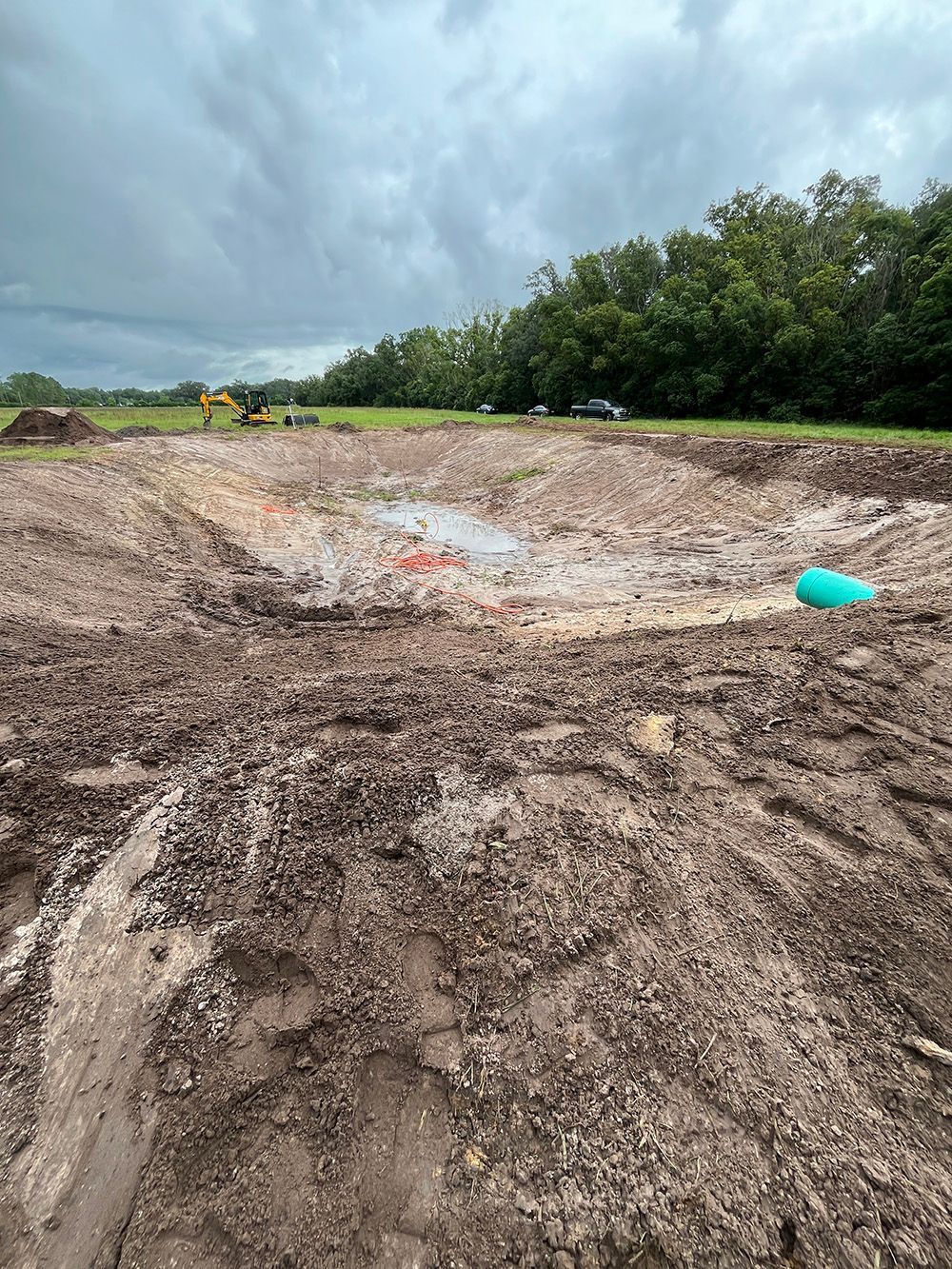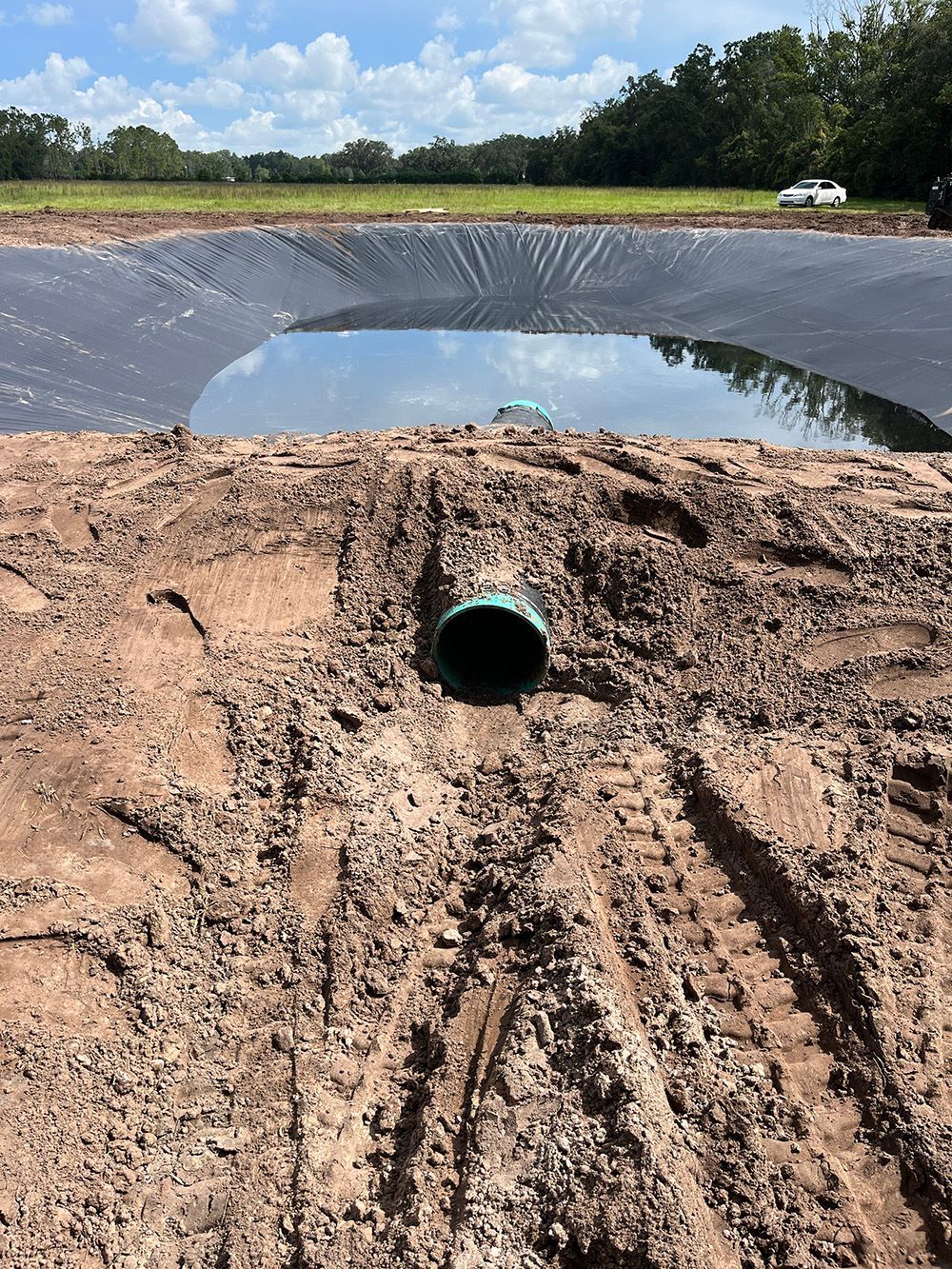While RPE liners are reliable enough to be used for landfills and containment projects, we focus on installing them for bass ponds or retention ponds that will not naturally hold water because of the Florida soil on that property. When dealing with a new farm pond, our team can dig the hole, install a geosynthetic liner, and even add aeration devices and live fish to create a new thriving ecosystem. Water bodies of this size are common in areas like Brooksville, Dade City, Spring Hill, San Antonio, and Plant City, where land can be sprawling and neighborhoods and cities do not cover the entire landscape. Read on to understand our process for using a RPE liner to start a new sport fish pond that will provide enjoyment and beauty for your family for years to come.
While centered in Tampa, we travel outside the area to more remote areas of Florida for pond digging projects. Counties such as Hernando, Pasco, Sumter, Lake, Polk, and Manatee tend to have more generous space than Hillsborough and Pinellas and are more ripe for designing a pond that can provide all kinds of enjoyment for your family.
Questions to Consider Before Lining a Pond
- There are many elements to consider when digging a new pond. Is your intended location for the pond at a low point or high point on your land? With the serious rains we get in Florida, having your pond in a low area can lead to flooding and erosion. If all the water runs toward your pond when it rains, it will be very easy for it to become overfilled. Where will the water go? If you're considering using a low point, you may want to plan on some kind of overflow system that diverts the water away from pond.
- If you have a piece of land and are considering adding a fish pond, think about what size body of water you'd like. Consider how much dirt needs to come out to accomplish that and if you'll have a place on the property to distribute the dirt. We've heard of people using the dirt to build on, piled high and deep to create a backstop for shooting, or given away to a supplier that has the ability to sell the dirt. These are all good scenarios. If you can't use the dirt on the land you will have the added expense of having it hauled away and disposed of. Depending on the size of the pond you're digging, this can be a substantial portion of the budget for the pond.
- Is the area/land level around the pond? Whenever possible, you want to have the sides of your pond be on an equal plane so that it holds water evenly. If one side is multiple feet lower than the other, as the pond fills up, the water will all exit in that one area and it may gravitate in a direction you'd rather not see it go. When we're designing and digging a pond basin, we'll use a transit level to check the corners and all sides to make sure we build up dirt in areas that are lower than others.
- How do you plan to fill your pond? Some extra large bodies of water can take weeks to fill with a regular garden hose. If you have access to well water and a larger hose like a 1" or 2" diameter, you'll stand a much better chance of getting your fishing pond filled by your water source. Depending on the season, letting rain water fill a pond is also a great option. Are you near the water table? In this instance, your pond may not need a liner or be able to accept a liner if water is constantly filling from beneath the surface.
Added Protection by Burying Your Liner
All of the products we use and install come with a manufacturers warranty. They are usually listed as lasting a certain number of years when exposed (meaning to direct sunlight) and a far greater number of years when buried. While the cost to install and bury a liner is more expensive than leaving it exposed, it greatly lengthens the lifespan of your liner. Replacing a liner can cost nearly the same amount as installing a fresh one which is why we prefer to add a layer of dirt to a new liner when building a pond. 6"-12" of dirt is usually sufficient to cover the liner and help protect it from cracking due to prolonged sun exposure.
Caution and expertise is needed when burying large liners because the weight of heavy machinery can damage the liner making it unusable. Spreading dirt by hand may not be a realistic option when dealing with ponds that are in the acre-size so we complete this work with heavy equipment. Specifically, this can be executed by building a thick dirt road in the pond that will cover the liner and allow access to vehicles. From here, we can transport fill dirt into the pond and begin to cover larger sections of the liner using our equipment. As you can imagine, this process can be time consuming and is much easier to pull off during the dryer months in Florida.
Woven Vs Non-Woven RPE
There are two major types of RPE fabric which are woven and non-woven. The difference is very much how it sounds as far as the construction of these two materials. The woven version is made up of tightly laced synthetic fibers. With a non-woven version, the fibers are bonded together during manufacturing. Non-woven RPE liners have higher permeability which mean they allow moisture to pass through more easily. This is more suitable for the purpose of a landfill, erosion stabilization, and where some drainage is allowed or needed like in filtration projects.
The strength of a woven material is higher than non-woven but the flexibility of that same woven material will be lower. Woven fabrics are better when the weight being applied is great or the highest possible puncture resistance is needed. When separating layers of soil, rock, or sediment, a non-woven geotextile will be a better choice given the permeability. If you're buying a new property and building on an existing one, you can rely on our team for a pond liner installation of any size in the greater Tampa area.
Lastly, while PVC is a frequently used material for many purposes, we like to go with RPE when dealing with any hole that needs to hold water. We feel this is in line with trends in the greater industry. PVC has been shown to break down faster in direct UV light than RPE and with our intense Florida sun, we prefer to offer greater and longer lasting UV protection. You'll still find wide use of PVCs across different applications but more often, new ponds are getting built with RPE installations.
Installation of Fish Pond Liners
Because of the weight of a RPE pond liner, the installation may require five or even ten people to help unroll the material and drag it into place. We can build a functional pond on your land with a totally turnkey process. We can supply the machinery and expertise to excavate a new pond, take measurements then procure the RPE material or any other liner membrane you may want, as well as supply and coordinate the labor to install and bury your pond liner. If you own land in Central Florida or you're looking at acquiring new land and would like a new body of water, we can visit the site and help you understand the options available based on space, location, conditions, and surrounding elements. There is a lot of planning involved in a project of this magnitude. Our understanding of pond construction can help save you headaches of trying to pull off such a large project by yourself.






